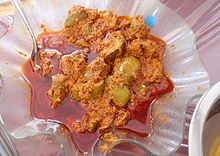food.wikisort.org - Dish
Avakaya (also known as mango pickle[1]) is a variety of Indian pickle popular in South India with its origin in Delta Districts of Andhra Pradesh. The main ingredients are mangoes, āvapiṇḍi (powdered mustard seeds) and a combination of other spices used for pickling. South Indians are known to have a deep attachment to these spicy pickles. A wide variety of pickles are available in these regions, using mango as their prime ingredient. Besides being made at home, the pickles are available commercially and are exported to the United States, Europe, Japan and many other countries.[2]
It has been suggested that this article be merged into South Asian pickle. (Discuss) Proposed since April 2021. |
Preparation
Avakaya pickles are usually made in the summer, this being the time for peak availability of green mangoes. Green mangoes, hot oil, chilies and a variety of spices are the key ingredients. The process of preparation, storage and serving is considered almost a ritual.
The mangoes are cut into medium-sized pieces approximately 2 cm x 2 cm using strong and especially sharp cutters/knives in swift strokes so as not to structurally damage the pieces. These pieces are wiped clean and dry with a highly-absorbent soft cloth — usually an old sterilized cotton sari with no embroidery, stowed away for this purpose. They are then pickled with powdered mustard, red chili powder (dried and powdered or sometimes dried, roasted and powdered), salt, gingelly oil. The mixture matures for four to eight weeks, care being taken to mix the contents periodically to ensure a uniform marinade.[3]
Popularity
Avakaya (Telugu version) is prepared during the pre-summer seasons when mangoes are just about to ripen. The Telugu version, is spicier then the Tamil version and sometimes contains chickpeas as one of the primary ingredients. It is prepared in many households and eaten along with curd rice.
Varieties





There are a wide variety of mango pickles,[3] these include:
- Āvakāya (The default one made with powdered mustard seed)
- Allaṁ Āvakāya (A spicy variety including ginger-garlic paste)
- Bellaṁ Āvakāya (A sweet variant of Avakaya made with jaggery)
- Dōsa Āvakāya (Mango replaced with a type of dosakaya) (bottle gourd)
- Māgāya (Made with green, peeled, unstoned mango)
- Menti Āvakāya or Mentikāya (Includes fenugreek)
- Nuvvulu Āvakāya (Includes sesame)
- Pacca Āvakāya (Avakaya with yellow chillies rather than red ones which are usually used.)
- Pulihora Āvakāya (Avakaya with tālimpu (Telugu), called Chaunk in Hindi)
- Senagala Āvakāya (Avakaya with the addition of chickpeas or Bengal gram or chana)
- Tokku Māgāya (Māgāya with the mango peel included)
- Tarum Māgāya (Māgāya made with grated mango)
- Uduku Māgāya (Māgāya with boiled rather than raw mango)
- Usiri Āvakāya (Mango replaced with gooseberry)
- Velluḷḷi Āvakāya (Avakaya with addition of garlic)
- Yenḍu Āvakāya (Avakaya with pickled, dried mango cubes mildly sweetened with jaggery)
- Kobbari Āvakāya (Avakaya made with coconut flavor)
Consumption
Hot rice is mixed with one or two pieces of avakaya and ghee (clarified butter) or groundnut oil, then made into bite-size balls. Avakaya is often eaten with rice and dahi (yogurt). Raw onion can be added which enhances the taste. Most people prefer to eat it along with muddapappu (pigeon pea dal) and neyyi (ghee/clarified butter). Some people prefer to eat it within 1–2 months from preparation, when it is called Kottāvakāya.[3]
See also
- List of fruit dishes
- Pickled fruit – Fruit that has been preserved by anaerobic fermentation in brine or immersion in vinegar
References
- Ranjan, Hriday (18 March 2019). "Ode to the humble garlic pickle". The New Indian Express. Retrieved 1 September 2019.
- Usha's Pickle Digest: The Perfect Pickle Recipe Book. Mrs Usha R Prabakaran (1998) 347 pag. ISBN 1797842382, ISBN 978-1797842387
- Pushpesh Pant. India: The Cookbook (2010) 960 pag, ISBN 0714859028, ISBN 9780714859026
Другой контент может иметь иную лицензию. Перед использованием материалов сайта WikiSort.org внимательно изучите правила лицензирования конкретных элементов наполнения сайта.
WikiSort.org - проект по пересортировке и дополнению контента Википедии
